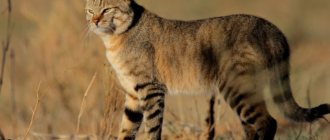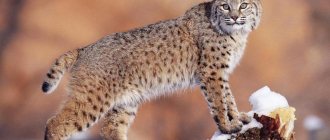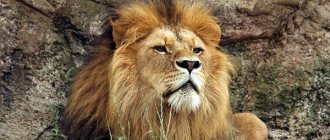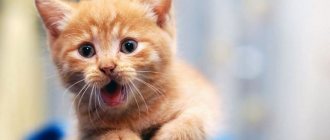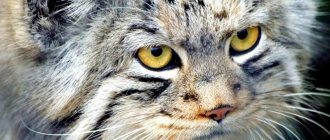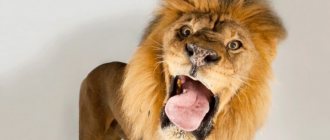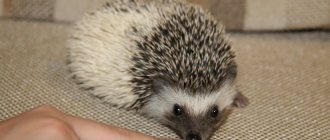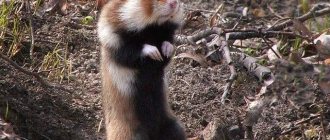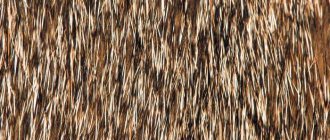Black-footed cat in the wild
Black-footed cats are endemic to southern Africa. They live in grassland and semi-desert areas, including arid open savanna, where small rodents and ground-roosting birds are abundant. Small predators settle in empty burrows of porcupines, aardvarks, as well as in devastated termite mounds, which is why they received their second unofficial name - ant tiger. Zoologists distinguish two subspecies of black-footed cats:
- Felis nigripes nigripes - found in Namibia,
- Felis nigripes thomasi (darker in color) - found in Botswana.
Little "tigers" are tireless hunters. In one night they can travel up to 16 km in search of small mammals and make one jump for prey every half hour. More than half of these jumps are successful. Black-footed cats hunt at night in all weather conditions, and their survival abilities are admirable. Not every dryland predator can boast that its menu consists of 54 species of different animals and birds. In addition, cats can go without water for a long time, absorbing as much liquid as possible from live food.
The black-footed cat leads a solitary lifestyle. Males occupy a range of up to 15 km2; it often overlaps with the ranges of females, which occupy about 10 km2. The boundaries of territories are marked by both cats and cats. But if cats mainly use marking odors, that is, they rub against objects, leave feces or urine in visible areas, and scratch with their claws, then cats can spray urine up to 12 times per hour. Cats' calls are very loud compared to animals of similar size. At close range, they use quieter sounds: purring, gurgling, hissing or growling if threatened.
Females reach sexual maturity at 8-12 months. The period of sexual activity lasts literally 1-2 days, and fertilization is possible only within a few hours. After courtship and mating, the couple separates. Pregnancy lasts 60-68 days. Then 1-2 half-naked kittens are born, which are completely covered with hair only by 6 weeks, but at 3 weeks they already begin to leave the den. It is interesting that in case of danger they do not return to the house, but scatter and hide in nearby shelters. They sit quietly until their mother calls. At the age of 7-8 weeks, babies try to hunt prey, which is brought to the mother’s den, and already at 3-4 months they begin to get food on their own. Cats can have up to 2 litters during the year.
The black-footed cat is listed in the International Red Book, as well as in Appendix I CITIES. hunting it is prohibited in South Africa and Botswana. In nature, black-footed cats number just over 13,000 individuals, of which about 10,000 are mature.
Video about African black-footed cats:
https://www.youtube.com/watch?v=QVXcKmw3qHI
History and geography of the African wild cat
African Bushmen say that this bloodthirsty cat even attacks giraffes. This is most likely an artistic exaggeration - given that we are talking about an animal weighing one and a half kilograms - but the African wild cat is truly one of the bravest hunters in the cat family.
The black-footed cat is a small but very dangerous predator
This smallest of the wild cats is also called the black-footed cat (lat. Felis nigripes), and sometimes the ant tiger. The first name refers to the characteristic “slippers” of coarse black wool on the soles of the paws; the second is due to the fact that the animal often settles in abandoned termite mounds, converting them into its home.
Habitat
The original habitat of the black-footed cat is the Kalahari, the desert regions of Southern Africa. The population is compactly distributed in several neighboring countries:
- SOUTH AFRICA;
- Namibia;
- Zimbabwe;
- Angola;
- Botswana.
The habitat of the black-footed cat is Southern Africa
Scientists distinguish two subspecies of the black-footed cat: the more numerous of them (Felis nigripes nigripes) has a fairly light color and lives mainly in Namibia, the number of the second subspecies (Felis nigripes thomasi) is smaller, its representatives live mainly in Botswana.
There is an official ban on hunting black-footed cats in Botswana and South Africa, but the population in these countries continues to suffer from poachers. Animals often die under the wheels of cars and from attacks by their main enemies - dogs. The species is considered vulnerable because its numbers are significantly affected by human economic activity. The animal is listed in the International Red Book and is protected by the CITES Convention.
Despite conservation measures, the number of the species is constantly decreasing.
Video: black-footed cat - a small predator
The rarest breeds of spotted cats
Among the variety of cats with leopard coats, there are those that have not yet become widespread.
These include:
- Australian mist. The breed appeared as a result of crossing Burmese, Siamese and Abyssinians. It has many color options. But spotted cats look the most impressive.
- California radiant. Among the ancestors of these spotted cats are Angoras, Siamese, Manx, British Shorthair and Abyssinians. California shiners have a “wild” appearance. And on their luxurious fur coat there is a tabby pattern.
- Ussuri cat. In all likelihood, this young breed comes from Siberian and Amur cats. The spotted Ussuri visually resembles a predator and has a proud, independent disposition.
- Sokoke or Kenyan forest. This breed originated from kazonzo and partially feral domestic cats. It was approved in 1992 thanks to the efforts of Jenny Slater. Small, flexible, slender, spotted cats are endowed with a wayward, independent character and have a developed hunting instinct.
Spotted cat - Australian mist
Spotted cat - Californian shining Spotted cat - Sokoke
Spotted cats attract attention with their natural grace and unusual exterior. Despite their “wild” appearance, many of them have a playful, affectionate disposition and high intelligence.
It is these qualities that make mini-leopards very popular among those who dream of getting closer to nature.
I like it I don't like it
Origin story
The Sokoke breed gets its name from the area of the same name in Kenya.
These cats descended from African forest cats and for a long time the breed was known only to Kenyan aborigines. The official beginning of the life of the breed can be considered 1978: this year, two kittens were taken by the owner of the coconut plantation, Janie Slater, who liked the appearance of the cats. Later, Janie brought kittens and began exporting their offspring to Denmark and Italy, where the oldest Sokoke lines can be traced. In the early 2000s, new blood was shed in the breed - other representatives of Kenyan cats formed the basis of a new line of Sokoke. The descendants of these cats continued their line in Europe and the USA. Subsequently, a genetic study was conducted which showed that Sokoke cats are a mixture of domesticated wild Asian and Arabian cats. This breed is now part of the Arabian Sea racial group based on their DNA affinity to Lamu Island cats and Kenyan spotted street cats.
Previously, Kenyan aborigines caught cats of this breed for food. Due to the peculiarities of the social system, eating livestock was unacceptable for local residents - it was considered a luxury item. Today, sokoke is not consumed as food. In nature, representatives of the breed are on the verge of extinction and are preserved only thanks to the efforts of animal rights activists and environmental services.
The Sokoke, or African Shorthair cat, has achieved standardized breed status. It is recognized by the major cat breeding associations and is a viable breed of domestic cat.
Pros and cons of servals
Living with such a miracle of nature as a serval under one roof is a pleasure. If you bought a small kitten, there is no particular need to equip it with a cage or enclosure. His behavior is not much different from ordinary kittens, and he feels very comfortable in the apartment. Only such an unusual pet needs to be raised from early childhood. This is necessary so that as he grows up, he still perceives you as his best friend.
Advantages of the breed:
- The special beauty of the animal;
- Balanced temperament, absence of causeless aggression;
- The serval is a very loving and devoted animal;
- Has almost dog-like habits (fetching balls, toys, fooling around) but moves around the house much more gracefully and accurately;
- Good health;
- Trained and performs even complex tasks;
- Friendly towards other pets at home;
- There are no hereditary diseases;
- Easy care.
Flaws:
- Servals are sometimes stubborn; you need to point out the limits of what is permitted;
- They jump on high furniture;
- A lack of toys leads to damage to objects around;
- Often everything overturns;
- Needs a lot of personal space;
- He responds to screams and force with aggression;
- Marks territory;
- High price.
The best weapon against bad behavior of a serval, as strange as it may sound, is a simple splash of water. In case of bad behavior, simply spray some water on your pet and explain to him that it is bad. He will hear and listen to you. In general, these cats are very smart and if you repeat the same remark to him several times, he will definitely understand.
Vaccinations and antiparasitic treatment
To prevent infectious diseases, bush cats are regularly vaccinated against rabies, calcivirosis, panleukopenia and rhinotracheitis. The first vaccination is given to a kitten at the age of 2-3 months with a mandatory repetition after 4 weeks. In the future, the African cat is vaccinated annually.
On a note. To avoid various complications, a bush cat is vaccinated only with drugs that do not contain active viruses.
To prevent diseases transmitted by worms, the African Serval is dewormed once a quarter. And to combat external parasites, special drops, collars and shampoos are used.
Wild spotted cats - pets
Wild leopard cats are very beautiful. The fashion for keeping them at home has arisen more than once in the human community. But not all representatives of the cat world can be safely placed in a house.
Today, only three spotted species are most widespread as pets.
Serval
The African bush cat is a medium cat. Body length with a short tail is up to one and a half meters, weight - up to twenty kilograms. A small head, long legs and high-standing large ears make this animal look like a cheetah.
In order for a Serval to grow up tame, it must be taken away from its mother in the first days of life and fed by hand. Therefore, you should only purchase such a pet from experienced breeders.
A properly raised kitten will grow into a friendly cat, but its wild roots must not be forgotten. An adult must have a separate enclosure.
Food: raw meat only
During growing up, great attention should be paid to ensuring that there is enough calcium in the diet. Children have fragile limbs and fractures often occur. The Serval's color is magnificent - dark spots on a reddish background.
The Serval's coloring is magnificent - dark spots on a reddish background.
Read more photos and interesting information about the serval in a separate article on Mister Cat.
Ocelot
A very bright animal, resembling a leopard in appearance, although smaller in size.
Less accommodating and less trainable than the Serval. An adult should only be kept in an enclosure. Nevertheless, it is often found today in home keeping because of the extraordinary beauty of its amazing colors. Such a pet named Babao lived with the famous artist Salvador Dali.
Geoffroy's cat
This small wild animal is similar in size to its domestic counterpart.
The brightly spotted skin was highly valued in the fur industry. Today this species is on the verge of extinction and is protected by the CITES Convention.
Therefore, it is now rarely found in home keeping, although it is popular. It is well tamed if at an early age the pet was taken from its mother and raised in the hands of a person. There are only a few breeders of this species, and it is difficult to acquire such a cat.
Mr. Cat recommends: description, characteristics, habitat
Felis nigripes - Black-footed cat or Ant Tiger - one of the smallest cats in the world along with the Asian rusty cat.
The main characteristics of the Ant Tiger include the following:
- Miniature sizes - weight about one and a half kilograms, in large males up to two and a half, body length from 35 to 55 cm, tail 10-20 cm.
- A large and beautiful head that does not violate the proportions of the body.
- Round and very large eyes that glow at night. In these animals, the retina is entangled in a vascular network, which causes phosphorescence. It is the tapetum that is responsible for the function of night vision, the increase in visual ability at this time of day and the bluish fluorescence of the retina.
- Large, high-set ears with a rounded tip.
- Strongly built body with an athletic build.
- Strong, but short limbs with a dense fleecy covering of the soles of the paws, protecting the animal from the hot surface of the sand. The pads are jet black in color and have fully retractable claws.
- The tail is medium length with a black tip and similar ring markings.
- Dense and thick wool, which has almost zero thermal conductivity. It is this structure of the fur that allows the cat not to overheat in the heat and not freeze at night, because temperature changes in the desert are great.
- The color is mainly sandy yellow with bright black markings.
- The ability to make peculiar ringing and loud sounds.
Since the beginning of this century, black-footed cats have been classified as a vulnerable species of animals; they are listed in the international Red Book and the second appendix of the CITES Convention on Trade in Wild Animals.
The main natural habitat of the miniature predator is the desert areas of the southern zones of the African continent. This is the Kalahari Desert, located in the lands of Namibia and Botswana, the southernmost points of Angola.
In the scientific classification, the Ant Tiger subspecies is distinguished:
- Felis nigripes nigripes lives mainly in Namibia;
- Felis nigripes thomasi is more common in Botswana.
The color may vary slightly between varieties; the Namibian subspecies has a peach background, and the Botswana subspecies has a dark chocolate background.
Chaotically located marks are unique for each animal and are never repeated twice; this color serves as camouflage during night hunting. Usually the darkest part is the head, and the lightest part is the abdominal region, chest and inner surface of the legs.
Advantages and disadvantages
We have already mentioned amazing qualities. However, do not forget that the Serval is not suitable for keeping in an apartment due to its very active and energetic nature and size. It requires large areas and constant supervision. Even if he is accustomed and dog-like attached to his person, the strong instincts of a mature wild cat, including hunting, will speak in him. The impressive and sharp claws and teeth can even cause serious injury unintentionally. Some owners declaw their cats because of this, but this operation is not humane because it involves removing part of each toe and essentially disables the cat for life.
To keep your belongings intact, take care of your pet’s leisure time
Another feature is that both males and females mark their territory by spraying urine on trees and bushes and rubbing it into the ground. The frequency of this process can reach up to 46 times per hour.
A serval who has been inadvertently hurt will definitely respond to his offender. He also does not get along well with small animals such as rodents and birds, since for a cat this is prey. Surprisingly, servals get along very well with domestic dogs.
A rare exotic animal requires high costs for raising and maintaining. If you want to buy a serval, you must take into account the high costs of maintaining a pet and prepare everything before the kitten arrives.
Many people, when buying a serval, believe that since the kitten is expensive, it will behave ideally, and that it will certainly become a kind of fashion accessory or luxury home decoration. This approach will not lead to a good outcome.
Based on the serval, by crossing it with a domestic cat and trying to use all the positive qualities of the serval and suppress its shortcomings, a new breed of domestic cat was bred, which retained its exotic appearance - the savannah. This is a real pet and a real house cat
It is possible that those who want to buy a “cheetah in miniature” should turn their attention to this
Links[edit]
- ^ abcd Yamaguchi, N.; Kitchener, A.; Driscoll, K., & Nussberger, B. (2015). "Felis silvestris" IUCN Red List of Threatened Species
.
2015
: e.T60354712A50652361. Retrieved October 29, 2022. - ^ a b Kitchener, AC; Breitenmoser-Würsten, C.; Eizirik, E.; Gentry, A.; Werdelin, L.; Wilting, A.; Yamaguchi, N.; Abramov, A.V.; Christiansen, P.; Driscoll, C.; Duckworth, J. W.; Johnson, W.; Luo, S.-J.; Meijaard, E.; O'Donoghue, P.; Sanderson, J.; Seymour, K.; Bruford, M.; Groves, C.; Hoffmann, M.; Nowell, K.; Timmons, Z.; Tobe, S. (2017). "Revised Taxonomy of Felids: Final Report of the IUCN Cat Classification Task Force of the IUCN Cat Specialist Group" (PDF). Cat News
(Special Issue 11): 17-20. - Vinh, J.D.; Guilaine, J.; Debue, K.; Hay, L., & Gerard, P. (2004). "Early domestication of the cat in Cyprus". The science
.
304
(5668): 259. DOI: 10.1126/science.1095335. PMID 15073370. S2CID 28294367. - ^ abc Driscoll, California; Menotti-Raymond, M.; Roca, A.L.; Hupe, K.; Johnson, WE; Geffen, E.; Harley, E. H.; Delibes, M.; Pontier, D.; Kitchener, A.C.; Yamaguchi, N.; O'Brien, S. J., & McDonald, D. W. (2007). "Middle Eastern origins of cat domestication". The science
.
317
(5837):519–523. Bibcode: 2007Sci…317..519D. DOI: 10.1126/science.1139518. PMC 5612713. PMID 17600185. - ^ abc Kingdon, J. (1988). "Wild cat (Felis sylvestris)". East African Mammals: An Atlas of Evolution in Africa, Volume 3, Part A: Carnivores
. University of Chicago Press. pp. 312−317. ISBN 978-0-226-43721-7. - Forster, G. R. (1780). “LIII. Der Karakal". Herrn von Büffons Naturgeschichte der vierfüssigen Thiere. Mit Vermehrungen, aus dem Französischen übersetzt. Sechster Band
[
Natural history of the quadrupeds of Mr. von Buffon. With additions translated from French. Volume 6
]. Berlin: Joachim Pauli. pp. 299–319. - Jump up
↑ Gmelin, J. G. (1791).
"Anmerkungen zu James Bruce Reise nach Abyssinien." Anhang zu James Bruce Reisen in das Innere von Africa, nach Abyssinien an die Quellen des Nils
[
Appendix to the travels of James Bruce in the interior of Africa, in Abyssinia to the sources of the Nile
]. Rinteln, Leipzig: Expedition der Theologischen Annalen, Johann Ambrosius Barth. pp. 1–38. - Desmarest, A. G. (1822). "LXIII. Chat, felis." Mammalogie or description des espèces de mammifères. Second party
. Paris: Agasse. pp. 540–541. - ^ abc Schwann, H. (1904). "On Felis ocreata, better known as Felis caligata, and its subspecies". Annals and Journal of Natural History; Zoology, Botany and Geology
.
Episode 7. 13
(74): 421–426. DOI: 10.1080/00222930408562473. - Jump up
↑ Cabrera, A. (1906).
"Mamiferos de Mogador". Boletín de la Sociedad Española de Historia Natural
.
6
: 357-368. - Heller, E. (1913). "New antelopes and predators from British East Africa". Miscellaneous Collections of the Smithsonian Institution
.
61
(13): 1–15. - Cheeseman, R. E. (1920). "Report on the Mammals of Mesopotamia". Journal of the Bombay Natural History Society
.
27
(2): 323–346. - Thomas O.; Hinton MAC (1921). "Captain Angus Buchanan's Expedition to Air. II. About mammals (except ruminants) obtained during the expedition to Air (Asben)". Novitates Zoologicae
.
28
(1): 1–13. - Jump up ↑
Thomas, O. (1926).
"Some New African Mammals". Annals and Journal of Natural Science
.
Episode nine. 17
(97): 180–184. DOI: 10.1080/00222932608633388. - Pocock, R.I. (1944). "Wildcat ( Felis lybica
) of Northern Benghella, Angola."
Annals and Journal of Natural Science
.
Series 11. 11
(74): 130–133. DOI: 10.1080/00222934408527412. - Pocock, R.I. (1944). "Wildcat ( Felis lybica
) of Palestine."
Annals and Journal of Natural Science
.
Series 11. 11
(74): 125–130. DOI: 10.1080/00222934408527411. - ^ab Pocock, R.I. (1944). "Races of the North African Wild Cat". Proceedings of the Zoological Society of London
.
114
(1–2): 65–73. DOI: 10.1111/j.1096-3642.1944.tb00212.x. - Harrison, D. L. (1968). " Felis silvestris gordoni
".
Mammals of Arabia: Carnivora, Hyracoidea, Artiodactyla. Volume 2
. London: Ernest Benn Ltd., p. 283. - ^ a b c d Johnson, WE; Eizirik, E.; Pecon-Slattery, J.; Murphy, W.J.; Antunes, A.; Teeling, E. & O'Brien, S. J. (2006). "Late Miocene radiation of modern Felidae: a genetic assessment". The science
.
311
(5757):73–77. Bibcode: 2006Sci…311…73J. DOI: 10.1126/science.1122277. PMID 16400146. S2CID 41672825. - ^ abc Werdelin, L.; Yamaguchi, N.; Johnson, W.E. & O'Brien, S. J. (2010). "Phylogeny and evolution of cats (Felidae)". In Macdonald, D. W. & Loveridge, A. J. (eds.). Biology and Conservation of Wild Felids
. Oxford, UK: Oxford University Press. pp. 59–82. ISBN 978-0-19-923445-5. - ^ abcd Li, G.; Davis, B. W.; Eizirik, E., & Murphy, W. J. (2016). "Phylogenomic evidence for ancient hybridization in the genomes of living cats (Felidae)". Genomic Research
.
26
(1): 1–11. DOI: 10.1101/gr.186668.114. PMC 4691742. PMID 26518481. - Ottoni, C.; Van Neer, W.; De Cupere, B.; Daligault, J.; Guimaraes, S.; Peters, J.; Spasov, N.; Prendergast, M.E.; Boivin, N.; Morales-Muñiz, A.; Balasescu, A.; Becker, C.; Benecke, N.; Boroneant, A.; Buitenhuis, H.; Chahoud, J.; Crowther, A.; Llorente, L.; Manaseryan, N.; Monchot, H.; Onar, V.; Osipinskaya, M.; Putelat, O.; Quintana Morales, EM; Studer, J.; Wierer, U.; Decorte, R.; Grange, T.; Geigl, E. (2017). "Paleogenetics of cat dispersal in the ancient world." Nature, ecology and evolution
.
1
(7):0139. DOI:10.1038/s41559-017-0139. - ^ ab Hufnagl, E.; Craig-Bennett, A. (1972). "African wild cat." Libyan mammals
. Cambridge, UK: Oleander Press. paragraph 42. ISBN 9780902675087. - ^ ab Rosevear, D. R. (1974). "Felis lybica Forster". Carnivores of West Africa
. London: Trustees of the British Museum (Natural History). pp. 384−395. ISBN 978-0565007232. - ^ ab Pocock, R.I. (1951). "Felis lybica, Forster". Catalog of the genus Felis
. London: Trustees of the British Museum. pp. 50−133. - Al-Safadi, MM; Nader, I.A. (1990). "First record of a wild cat, Felis silvestris
Schreber, 1777 from the Yemen Arab Republic (Carnivora: Felidae)."
Mammalia
.
54
(4):621–626. DOI: 10.1515/mamm.1990.54.4.621. S2CID 86461554. - Nowell, K.; Jackson, P. (1996). "African wildcat Felis silvestris, group lybica (Forster, 1770)". Wildcats: A Status Review and Conservation Action Plan. Gland, Switzerland: IUCN/SSC Cat Specialist Group. pp. 32-35. Archived from the original on March 3, 2016. Retrieved September 23, 2006.
- ^ abc Gippoliti, S. & Amaury, G. (2006). "Ancient introductions of mammals in the Mediterranean Basin and their implications for conservation". Review of Mammals
.
36
(1): 37–48. DOI: 10.1111/j.1365-2907.2006.00081.x. - Vigne, J.-D. (1992). "Zooarchaeology and biogeographical history of mammals of Corsica and Sardinia since the last Ice Age" (PDF). Review of Mammals
.
22
(2): 87–96. DOI: 10.1111/j.1365-2907.1992.tb00124.x. - Mattucci, F.; Oliveira, R.; Bizzarri, L.; Vercillo, F.; Anile, S.; Ragni, B.; Lapini, L.; Sforzi, A.; Alves, PC; Lyons, L.A. & Randy, E. (2013). "Genetic structure of wild cat (Felis silvestris) populations in Italy". Ecology and evolution
.
3
(8):2443–2458. DOI: 10.1002/ece3.569. - Dragesco-Joffe, A. (1993). "African wild cat, ancestor of the domestic cat." La vie sauvage du Sahara
. Lausanne: Delachau and Nistle. pp. 134−136. - ^ ab Smithers, R. H. N. (1971). Mammals of Botswana
. South Africa: University of Pretoria. - Jump up
↑ Estes, R. D. (1999). Safari Companion. Books by Russell Friedman. ISBN 978-1-890132-44-6. - Herbst, M.; Mills, M. G. L. (2010). "Feeding of the South African wildcat, a facultative trophic specialist, in the southern Kalahari (Kgalagadi Transfrontier Park, South Africa/Botswana)." Journal of Zoology
.
280
(4):403-413. DOI: 10.1111/j.1469-7998.2009.00679.x. - "African Wildcat". Alley Cat Rescue
. Retrieved September 23, 2022. - BBC Earth. “A wild cat born of a domestic cat! - Creation of baby animals".
- "Libyan stamps online". Archived from the original on 2012-02-17. Retrieved April 12, 2009.
Serval - description of the breed
Adult servals are slender, agile animals, approximately 60 cm long from shoulder to tail. Males weigh 9 - 18 kg, and females 9 - 13 kg. Thus, they are almost 20 cm taller than South American ocelots, which have a similar body length, and about 30.5 cm taller than the caracal, which has a similar weight. The serval has a small head with large round ears. The legs are very long: in the entire cat family, no other species has such long legs in proportion to the body. The tail is of medium length, reaches forty centimeters, the body is very slender.
Their legs and ears are considered the largest in the cat family. The serval is similar to the sympathetic caracal, but has a narrower footprint, a rounded skull, and no prominent ear tufts. It resembles a cheetah in structure and coat pattern, but not in size. The serval is similar in adaptation to marshy habitats with the jungle cat. Both cats have large, pointed ears that help locate prey.
In April 1986, the first Savannah cat was born, a cross between a male Serval and a domestic cat. The specimen was larger than a typical domestic kitten and resembled its father in its pattern. This cat breed has the habit of following its owner like a dog and can be a good swimmer. Over the years, the hybrid has gained popularity as a pet. The Savannah may be a better option than the Serval for people who like the appearance of the animal but want a more docile pet that is easier to care for.
Distribution and habitat[edit]
The African wildcat is found in Africa, the periphery of the Arabian Peninsula and the Middle East, as far as the Caspian Sea. [27] It is found in a wide range of habitats, particularly in hilly and mountainous landscapes such as the Hoggar Mountains. In deserts such as the Sahara, the density is much lower. It ranges across the north-Saharan region from Morocco to Egypt and inhabits tropical and subtropical grasslands, savannas and sub-Saharan shrublands from Mauritania to the Horn of Africa, including Somalia, Eritrea, Ethiopia, Djibouti and Sudan. Further south, it is present in all countries of Eastern and Southern Africa. [1]
On the Mediterranean islands[edit]
Wild cats in Sardinia are descended from domestic cats. [28]
The wildcat of Sardinia and Corsica has long been considered an African subspecies of wildcat with the scientific name Felis lybica sarda
. [25] Zooarchaeological findings indicate that it is descended from domestic cats, which were introduced probably early in the first millennium and originated in the Middle East. Today these populations have gone wild. [29] [28]
The wildcat on the island of Sicily is the European wildcat. [28] [30]
Diseases
Animals of this species have good health and very strong immunity. With proper care, Serval cats practically do not get sick.
Servals can suffer from diarrhea, which not only makes the animal uncomfortable, but can also lead to dehydration. If you notice loose stools in your pet more than twice in a row, immediately contact your veterinarian.
Serval kittens can experience fractures. This happens because their paws grow very quickly, and their bones are very fragile. Make sure that the kitten does not jump from great heights. If an accident does happen, see a doctor as soon as possible!
In any case, if you notice something wrong in the behavior of your pet, contact your veterinarian as soon as possible to avoid disastrous consequences.
Interesting Facts
The friendly and peaceful nature of Sokoke cats is dictated by the fact that this breed was developed as a result of a hybrid crossing of feral cats and feral domestic cats. Despite their exotic and even wild appearance, cats are perfectly adapted to living in city apartments with people.
Interesting video about the breed:
Kenyans call these cats “kanzonzo,” which literally translates to “barking.” This name stems from the times when African cats were hunted for their edibility. The natives had difficulty catching their cat as prey because their spiral pattern on their brown coat resembled that of tree bark and provided extraordinary camouflage in jungle environments.
Work on breeding Sokoke in Europe began when a friend of the “discoverer” of the breed brought one of the kittens to a cat show in Denmark, where he was immediately recognized as a miniature cheetah. The exotic appearance captivated the Europeans, and since then work began to standardize the breed.
Cornish Rex
Another representative of the cat, whose coat can be not only black, but also wavy. The dense thick fur of these cats is very warm. The shape of the head and ears gives a resemblance to bats. Representatives of the breed are distinguished by their special gracefulness, flexibility, dry and muscular constitution. But their main highlight is their character - they adore their owner, can be held for a long time, caress and show tenderness. They cannot stand screaming, noise or large groups. In turn, they themselves will not meow a lot and do not show aggression.
The breed was developed in the USA by crossing Orientals and cats with curly hair, the first of which appeared on an English farm in the first half of the 20th century. At first, the British themselves tried to develop a new breed, but the curly gene was recessive, so it took a long time to establish it.
Pet size
You can distinguish an ordinary street cat from a purebred cat by its size. The vast majority of simple murkas do not exceed 50-75 cm in length (80-105 cm with tail). At the same time, the body weight of a cat varies between 4-6 kg, and that of a cat - 2-4 kg.
Pedigree animals can weigh much more - 15-20 kg, and be very tiny, whose weight does not exceed 1.3-2 kg.
Big cats
Giant cats belong to the following breeds:
Breed of large cats Maine Coon
- Maine Coon (see photo above). The largest breed of cats, males weigh from 5.9 to 8.2 kg (castrated - up to 12 kg), and females from 3.6 to 5.4 kg (sterilized - up to 7.5-8.5 kg). The height at the withers in adult cats reaches from 25 to 41 cm, and the total length with the tail is up to 120 cm (tail length up to 36 cm).
- Turkish van. Adult cats weigh on average from 6 to 9 kilograms, females - from 4.5 to 6 kilograms. The length from the nose to the tip of the tail is from 90 to 120 cm, the height at the shoulders is 35-40 cm.
- Maine Coon. The largest breed of cats, males weigh from 5.9 to 8.2 kg (castrated - up to 12 kg), and females from 3.6 to 5.4 kg (sterilized - up to 7.5-8.5 kg). The height at the withers in adult cats reaches from 25 to 41 cm, and the total length with the tail is up to 120 cm (tail length up to 36 cm).
- Norwegian forest. The breed has a so-called “triple” base coat with a thick undercoat and characteristic long outer hair along the ridge and on the tail, which has a water-repellent property, large ears with tassels, a long fluffy tail, reaching a length of up to 3/4 of the length of the cat’s body.
- Chartreuse. The physique of animals is dense, strong; males reach a weight of 6-7 kilograms, females - 4-5 kilograms. Wool is allowed to wear any shades of blue, but a light gray-blue tone is preferred.
- The Kurilian Bobtail is a short-tailed cat with a pom-pom tail.
- Savannah is a large cat. Its height at the withers reaches 60 cm, and its weight reaches 15 kg. Distinctive features of the savannah are an elongated body, an elongated neck, long legs, large round ears and thick spotted fur.
- The Siberian cat
is a breed of semi-long-haired cat. The Siberian cat has semi-long thick hair that does not allow moisture to pass through, medium-sized ears, and a fluffy tail. The color is different. - British Shorthairs
are short-haired cats. As a rule, these are strong and robust cats. They come in medium to large sizes. - The Pixie Bob is an artificially bred breed of cat that looks like a lynx.
- The Egyptian Mau
is a short-haired, medium-sized breed of cat with a spotted coat. Their spots are found not only on the fur, but also on the skin. - Ragdoll
(eng. Ragdoll - “rag doll”) is a breed of large semi-long-haired cats. The average weight of cats is 4-6 kg, adult cats 7-10 kg.
Little cats
You can determine whether the purchased kitten belongs to mini-cats by comparing it with representatives of the following breeds:
Small cats of the Munchkin breed
- Munchkin. You can’t walk the catwalk with such short legs, but small legs left a big mark on the history and formation of small cat breeds.
- Napoleon (the result of crossing munchkins and Persian cats). Typically weighs about 2.5 kg.
- Bambino (the result of crossing this time short-legged munchkins and hairless Canadian sphinxes). The lower weight bar is 2.2 kg.
- Lambkin, a curly-haired lamb cat. An adult lambkin can weigh 1.8 kg.
- Skookum. The ancestors of this breed include the already familiar Munchkins and LaPerm cats, the ones with such long and wavy hair.
- Dwelf, a hairless breed created according to the formula: Munchkin + Canadian Sphynx + American Curl. The weight of these babies rarely exceeds 3 kg.
- The Singaporean cat is a breed of short-haired cats of small size and oriental type, with smooth hair and a golden-cream color characteristic only of this breed.
- Minskin. A breed of short-legged cats, the main feature of which is their fur; it is thick, dense, of excellent texture, which grows in islands on an almost naked animal.
- Kinkaloo is an extremely rare cat breed. Today there are only a few cats of this type in the world. A breed of cat developed by crossing Munchkins and American Curls. Kinkalows are distinguished by their curled ears and short legs. By the way, for reference, a Kinkalow cat sometimes weighs 1.3 kg.
Health
Servals usually do not have health problems if the owner takes a responsible approach to keeping the pet. First of all, this is a balanced diet adapted to the needs of a wild predator, timely vaccination and treatment against helminths, as well as systematic observation by a specialist. Even before purchasing a kitten, you should take the trouble to find a veterinarian who works with such exotic animals and understands their specifics.
While the kitten is still small and not fully formed, monitor its movements and make sure that the jumping cat does not harm its still weak paws. In young individuals, the limbs are still quite fragile and the likelihood of injury increases.
How to choose the right kitten
You need to buy a serval kitten not from random people, but from a specialized nursery. Otherwise, there is a risk of purchasing a sick animal brought into the country by smugglers. In Russia, the rules for keeping pets are becoming stricter. Therefore, before purchasing, it is important to make sure that the kittens on offer were born from a pair of servals who live in the country.
You need to choose a bush cat in person, and not from photos or video materials. To make your final decision, you should pay attention to the following factors:
- availability of documents;
- conditions of detention;
- behavior;
- appearance;
- health status.
Kitten care
In order for Serval kittens to acquire the character and habits of an ordinary pet, they must be adopted into the family no later than 5 months of age. A whole room is allocated for the pet, in which there are no high cabinets or racks with shelves. There they set up a nest for him and leave him bowls, toys and a tray.
Important! Growing African cats have weak limbs, so jumping from great heights is contraindicated for them.
Siberian cat
According to some experts, the Norwegian cat and the Siberian cat have common ancestors. Despite this, the Siberian cat is distinguished by both intelligence and intelligence. Moreover, its weight can reach 12 kilograms.
These cats grew and developed in the conditions of the Far Eastern taiga, so they are absolutely fearless animals that are not afraid of their natural enemies.
The Siberian cat is not only smart, but also beautiful, and also not spoiled by selective artificial selection. She is an excellent example of a real hunter, as she is able to hunt even hares.
The Siberian cat has a calm and balanced disposition, which helps her find a “common language” with both adults and children. At the same time, she will easily show who is “the boss”, regardless of who is in front of her, a cat or a dog.
Puberty and reproduction
Black-footed cats are ready to breed all year round. As soon as the female begins to estrus, males living nearby enter the rut.
At the same time, the female actively marks the territory and emits calling cries, signaling her readiness.
Males also make peculiar sounds during the mating season; the process itself takes a very long time - from five to ten hours.
After the mating has taken place, the male immediately loses interest in the female; all care for bearing and caring for the offspring now rests only with the mother.
By the end of the first month of life, they already leave the den from time to time to play. In case of danger, they do not try to quickly run into a shelter, but, on the contrary, run away from it and hide nearby, waiting for the mother to come to the rescue.
The kittens need the absolute presence of the mother for five days, then the female increasingly leaves the babies, going hunting and teaching the cubs to be independent.
By one and a half months, the babies have acquired thick fur; during this entire period they feed only on their mother’s milk, then they begin to get accustomed to the fresh meat that the female brings them. From this time comes the moment of learning hunting skills and survival.
From two to three months, kittens already go hunting with their mother, actively exploring the world around them.
Initially, the mother brings a half-strangled but living victim into the hole; the goal of the brood is to finish it off.
By four to five months, the babies are already so well trained by the female that they are able to hunt on their own and soon leave their mother for a solitary life. This is a very early period for representatives of the cat family. but usually barely half of the young Black-footed cats survive to the first year of life; most of them die from pythons and viper bites.
By 8-9 months, females become sexually mature, males a little later.
In natural conditions, Ant Tigers live from seven to ten years, but in captivity they have lived up to twenty.
Australian smoke
Animals of such breeds appeared in Australia by crossing the Abyssinian and Burmese breeds. The coat color consists of several shades, it can be peach, lilac and even blue. The eyes are almond-shaped and the coat is short. They only have green eyes. The body is medium in size and the neck is small. The ears are large, gradually tapering, and slightly curled at the edges.
“Spotted cats are perfect for families with small children. When they play with children, they don’t use their claws, their character is sincere and calm.”
Spotted cat breeds are very intelligent creatures and can make wonderful company for their owner. They are not capricious and are easy to learn at home. In order for your pet to love you and treat you well, it is enough to surround him with love and try to forgive him his little pranks.
Spotted cats are simply magnificent, they are one hundred percent suitable for keeping in the house. If you treat them well, they will reciprocate your feelings.
How is a wolf different from a dog?
The wolf is distinguished by stronger and higher legs, large paws, and an elongated head. The forehead and muzzle are wider, with a lot of fur on the sides. In general, the muzzle is much more expressive. For example, scientists were able to identify approximately 10 emotions that a wolf expresses.
The tail of a predator is thicker and longer. He doesn't have the habit of wagging his tail like dogs do. A lowered tail indicates the calmness of the animal, and a twitching tail indicates dissatisfaction.
Wolf and dog
Wolves have thicker, coarser, and denser fur. It consists of undercoat and coarse hair. Therefore, the predator is reliably protected from cold, water, and dirt. As the weather gets warmer, wolves gradually shed their winter fur, and some may change color.
Another distinguishing feature is footprints. The wolf leaves larger prints (8.5-11 cm) than the dog. The two middle fingers stick out more forward, and the side ones are set back. The tracks look more crowded. Predators try to stay further away from people and their homes, while dogs, on the contrary, come closer.
Trail of a dog and a wolf
Determining the breed
Only an experienced specialist can accurately determine the breed of a cat. But every owner, when purchasing a cat, wants to be sure that he will not be deceived. And they won’t slip a half-breed instead of a purebred animal. Or, having a mustachioed pet, he wants to check whether his cat has the characteristics of any breed. Outbred cats are similar to each other. But if the animal has distinctive features: unusual color, eye color, ear shape, tail structure. It is quite possible that it could not have happened without a purebred parent. Each breed has its own distinctive characteristics. The breed can be determined by the following:
- by appearance;
- according to body size;
- head;
- eyes;
- unique features;
- wool;
- coat color;
- unusual body structure;
- the nature.
Education and physical activity
Servals are smart animals and are easy to train. In the process of their upbringing, the following principles should be adhered to:
Temperamental and active, bush cats love to jump and hang on ropes and wires. African servals love to chew everything in sight, so to avoid damage to property they are provided with a sufficient number of durable toys. And to prevent cats from sitting idle, they can be trained to walk on a leash.
Petersburg Sphinx
For this miracle of nature, cat lovers should thank Russian breeders. It was they who managed to obtain such unique beauty in 1994. For a long time they crossed Oriental cats and Don Sphynxes.
There is virtually no hair on the body of these cats or only small, barely noticeable hairs. This rare cat exudes elegance from all sides, expressed in a slender build, an elongated head and impressively sized ears set to the sides.
Pets are not lacking in friendliness, curiosity, and affection. Communication with a person comes first for them; cats find it difficult without him. Pronounced mental abilities and excellent communication skills help cats learn easily and quickly. The cost of these beautiful creatures varies between 300-1300 dollars.
Saving [edit]
African wild cat on a 1994 Azerbaijan stamp
The African wildcat is listed on Appendix II of CITES. [1]
Alley Cat Rescue is currently the only known organization with a program specifically aimed at conserving African wild cats and reducing what some call genetic contamination of domestic cats. [35]
It has been discovered that the domestic cat can serve as a surrogate mother for wild cat embryos. The many similarities between the two species mean that an African wildcat embryo can be carried and carried by a domestic cat. The BBC documentary details the experiments that led to this discovery, and also shows a mature wild cat born to a surrogate woman. [36]
Description of the species
The secretive lifestyle of the black-footed cat limits observation of it in its natural habitat. Scientists make their assumptions about representatives of the species based on observations of animals kept in captivity - but the behavior of a wild cat in nature can differ significantly from its “captive” image.
External data
The weight of the small predator rarely exceeds one and a half kilograms, the average body length is half a meter - the length of the tail is 10–20 centimeters. The black-footed cat has a strong, stocky body, a large round head and huge, very expressive eyes, flickering in the dark with an infernal bright blue light. The animal has excellent vision at night, has sensitive hearing and a keen sense of smell.
In the twilight, the eyes of a wild cat glow with blue light
The main color of the coat can vary from light sand to reddish-brown; against this background there is a “wild” pattern of black spots, sometimes merging into stripes. The camouflage coloring perfectly camouflages the wild African cat, making it invisible to both enemies and prey. The paw pads below are reliably protected by dense fur from the hot desert sands.
The art of camouflage for the black-footed cat is a matter of survival
Character and lifestyle
Wild African cats do not build shelters for themselves - they develop ready-made rabbit holes or even termite mounds. They also occupy the burrows of other animals - porcupines, striders or aardvarks, having previously expelled their previous owners from them or simply eaten them for lunch. In these secluded and well-protected places, predators prefer to sit out during daylight hours, and at dusk they go out hunting, walking up to ten kilometers per day. They tolerate both heat and drought well and can go without water for a long time, getting moisture from food.
During the day, the predator sleeps in a shelter, and at night it goes hunting
The hunting grounds of males can reach fifteen square kilometers, while the territories controlled by females are usually three to four times smaller. Animals regularly mark their borders and jealously protect them from strangers.
A wild African cat jealously guards the boundaries of its possessions
Video: life of a black-footed cat litter in natural conditions
Nutrition
The diet of the black-footed cat is quite diverse - it includes up to fifty different types of prey: rodents, birds, insects, reptiles and amphibians. A brave predator is not afraid of the size of the prey, and she easily decides to attack an animal twice her size. Moreover, such an attack is most often successful.
The black-footed cat has a good appetite and attacks even animals twice its size.
Reproduction
During the period of love games, a cat and a cat, who the rest of the time lead a solitary lifestyle, unite in a pair. In due time - after just over two months - the fruits of love are born. There are most often two kittens in a litter, but in general there are no more than four. The mother raises and raises them independently, without the participation of the second parent.
The black-footed cat is a caring mother who raises kittens on her own
Kittens are milk-fed for up to one and a half months, but the cat begins to treat them to fresh meat quite early. By the age of five months, children reach the dimensions of an adult animal, but for another two to three months they live close to their mother, until they become completely independent. Full sexual maturity of young animals usually occurs by one year or a little earlier.
Life in captivity
Zoos around the world contain several dozen individuals of this species. According to experts, black-footed cats are of much more scientific than exhibition value - they are quite unsociable and almost never show themselves to visitors during the day, leaving their hiding places only at night.
Video: wild African cat in the zoo
Content Features
Despite the fact that the species is rightfully considered rare, keeping its representatives in captivity is not particularly difficult. The African cat has good health and high resistance to diseases. It is unpretentious in nutrition and does not require overly spacious, specially equipped enclosures. The lifespan of a predator in a zoo can reach fifteen years.
This species is very rare not only in the wild, but also in zoos
When normal conditions are created and proper care is provided, black-footed cats reproduce well in captivity, but the litters are small - one or two kittens. It is advisable to reliably isolate a pregnant female from external stimuli, otherwise she will become overly nervous and may abandon newborn babies, who will have to be artificially fed.
Zoologists are considering the possibilities of reproducing a rare species in captivity using the most advanced scientific techniques. In 2011, the Endangered Species Research Center (USA) carried out a successful experiment that had been prepared for seven years - it used frozen embryos and the method of artificial insemination. Two spotted brothers were born “from a test tube” by a surrogate mother - a black-footed cat named Bijou.
“Test Tube Brothers” was born and raised by a surrogate mother
As for taming an animal, any attempts to domesticate a wild cat are doomed to failure - the genetics of a predator are too strong in it. For this reason, the black-footed cat is very rarely kept in private zoos, which is more likely to benefit it than to harm it.
Serengeti
The breed was developed by crossing several breeds:
- Bengali;
- oriental, tabby color;
- Abyssinian;
- home;
- European shorthair, wild color.
This is a new breed of expensive and rare short-haired cats. They have a large, slender and graceful body with well-developed muscles. Representatives of this breed have a predatory spotted color, in brown, silver-gray and black tones.
They have short, thick, silky fur, and their legs are very long, slender and muscular. The Serengeti's character is sociable, playful and active. Pets have a fighting disposition, but with their owner and children they are kind and sweet.
Types of wool
You can understand what breed a domestic kitten or an adult cat belongs to by the length and structure of the coat. The coat of different cats can vary greatly.
Longhair
Cats with long hair look especially elegant - it is no coincidence that they were once considered a kind of symbol of wealth and luxury... And even now, even despite the specific difficulties of care, these “fluffy creatures” remain popular pets all over the world.
The following cats have long, thick hair with a densely packed undercoat:
Longhaired Himalayan cat
- The Himalayan cat has thick and long hair, a Siamese color with a light body and darker muzzle, paws, ears and tail, a characteristic “flattened” muzzle with exceptionally blue eyes, a rounded but strong body with short and muscular limbs.
- Napoleon. The breed, already familiar to us, can do a “baby face” and this wins thousands of hearts.
- Norwegian forest cat. The standard wardrobe of this breed is long hair, mandatory sideburns, trousers and a winter collar.
- The Turkish Van has a silky coat of medium length without a thick undercoat, shorter on the neck and shoulders, but longer on the “panties” and tail, an elongated and muscular body with a well-developed chest and strong limbs, pink paw pads, and tufts of hair between the toes.
- Turkish Angora - semi-long silky coat, practically devoid of undercoat, large ears with straight outer contours and pointed tips, set high and close, an elongated “dry” body with a wedge-shaped head, elongated and slender legs and a long tail, blue (but possibly multi-colored eyes ) almond-shaped.
- The Persian cat has a long (up to 12 cm), thick and silky coat (on the neck, shoulders and chest there is a lush collar), a squat build with short and muscular legs, a characteristic “flattened” face, on which a small, wide and snub nose
- Neva Masquerade - thick and long hair, lush “pants” and a perfectly furred tail, “heroic” physique with strong limbs, necessarily blue eyes of various shades (from light to sapphire), Siamese color with a characteristic “mask” on the face (and with age “markings of a dark color” – also on the tips of the paws, ears and tail).
- Maine Coon - long and thick hair that fits tightly to the body, large ears with sharp tips, decorated with “tassels” and located at the very top of the head with a “square” shape, a large body with a wide chest and muscular build, a large head with “lion outlines” "(especially in cats), long fluffy tail.
- The Burmese cat has beautiful silky hair with a thick mane on the neck and wavy belly cover (lighter than on the back and limbs), a characteristic color (reminiscent of a Siamese) with dark paws, muzzle, ears and tail and white “socks”, strong and massive body with a wide and rounded head, round eyes necessarily sky blue.
- The Somali cat has long hair of a very soft and delicate structure, shorter on the shoulders, large, alert ears with a wide base, moderately pointed tips and the inner surface of the auricle covered with tufts of hair, medium build with well-developed muscles and a “fox” tail.
- Nibelung - soft, medium-length coat of solid blue color with a distinct silvery tint, with a thick undercoat and not very noticeable collar and “pants”, slightly elongated and muscular body with long limbs and tail, straight nose with a blue-gray lobe, large widely spaced eyes oval in shape and rich green (possibly amber) color.
- Ragamuffin - a dense, but at the same time smooth and silky “fur coat”, a kind of mane around the neck and outer edges of the muzzle, highly developed decorative hair on the neck and hind legs, a thick tail at the base, covered with long and dense plume-type hair, a powerful physique with a pronounced fat pad on the abdomen, bright and rich eye color (regardless of color).
Serval lifestyle
Animals are nocturnal predators. Most of the serval's prey is small animals (rodents). The diet also includes hyraxes, lizards, hares, insects, snakes and frogs. During the hunt, servals freeze and stand motionless, listening to rustling sounds. Having heard prey, cats quickly attack it. In the process of chasing rodents, animals are able to dig holes and also climb trees. Servals can jump up to 3.6 meters in length. Cats jump no less quickly in height. They shoot down birds in mid-flight, jumping three meters. The animals have long legs, which allows them to reach speeds of up to 80 km/h. Thanks to this, servals can hunt antelope, deer and gazelles. Experts say that these wild cats are excellent hunters, because in 50% of cases they return with prey.
Servals live alone. Representatives of the stronger sex control a territory of up to 30 km. sq. Females are not so active. Their territory does not exceed 20 km. sq.
Long-tailed or margay
Margay
Habitat: northern South America - up to Mexico. Found in Texas. Margal is a tree cat. The long-tailed one is called that because it has a long tail, which allows the margay to balance when climbing thin branches.
The length of the margay is 90-120 cm, almost half of which is the tail. Weighs 2.5 – 4 kg. Limbs are long. A unique ability of margays is that they can turn their hind legs 180. Being ideal tree climbers, margays can hang on branches, clinging to it with one leg. The auditory organs are rounded, darkish on the outside and with a white spot in the middle. The eyes are large, like all nocturnal animals. Color – dark brown. The pupils are oval.
The spots are uneven in color intensity: darker towards the edges.
Hunts small mammals living on branches, birds, lizards, frogs, insects. Even small monkeys become prey for the margay.
Character and behavior
The black-footed cat's personality belies its tiny size. These animals are determined and aggressive, capable of attacking (and killing) prey larger than themselves.
Toyger (cat): detailed description of the breed
Such cats live only alone and meet only during the breeding season for mating. When a person or a large predator crosses the border of a habitat, ant tigers prefer to hide. But if there is no opportunity to escape, then the African cat will defend itself truly fiercely. A mother protecting a kitten can even drive away a jackal.
Note! The Bushmen have a legend about a black-footed cat that killed a giraffe. However, researchers reasonably doubt this.
The aggression of a small predator is not comparable to its size
Diet
In nature, the ant tiger's menu includes:
- larks;
- locusts;
- gophers;
- long-eared mice;
- spiders;
- gerbils;
- termites;
- lizards;
- butterflies;
- fresh and dry grass.
Note! If you're lucky, even a bustard, hare or anteater can become prey.
During the night, a cat eats up to 300 g of food, and sometimes more. Scientists recorded that one small predator ate 450g overnight, which was more than a fifth of its weight. This appetite is due to the high metabolic rate.
It is advisable to minimally disturb the natural biorhythms of the ant tiger. There is no need to transfer the animal's activity to the daytime. Therefore, feeding is carried out at night every 40-50 minutes. in small portions. Most of these desert inhabitants prefer meat along with sinews and cartilage tissue. Chicks and quails are given with their feathers. Fresh meat is supplemented with industrial feed and boiled eggs. To create a proper balanced diet, it is better to consult a veterinarian.
Important! It is not advisable to give fish, since it is not part of the predator’s natural diet.
After a successful hunt, the animal can bury the prey
Bengal
The result of crossing an Asian leopard cat and a short-haired domestic cat. The ancestors of this breed continue to lead a wild lifestyle, but their “heirs” are perfectly domesticated and, perhaps, have retained only their unusual color and flexible powerful body from the old days. The fur of the Bengal cat deserves true admiration - smooth, shiny, dense texture and characteristic coloring in the form of spotted tans of a golden-orange hue. This mini-leopard has a tolerant character, which allows him to get along even with dogs. Due to its genetics, the animal loves to climb trees, is not afraid of water and has an instant reaction.
How much does an exotic animal cost?
If, after all that you have learned about this temperamental and exotic animal, you are even more interested in having one at home, then the most pressing question for you will be the price. First of all, you should understand that the high price of the African black-footed cat is because this species of cat is considered endangered and therefore rare. And the significant decline in their population is not caused by poaching and trapping, but by deteriorating environmental conditions and the impact of ecology on the habitat of these predators. No one knows the exact price of a black-footed cat. It all depends on the breeder and the purebred of the breed. Thus, the minimum prices for a purebred wild cat start from 10-12 thousand dollars.
But, fortunately, today many nurseries practice crossing wild animals with other species, for example, velvet and domestic ones. Thanks to this process, the new cat species retains the color and shape of its black-footed ancestors, but takes on the character of the domesticated cat. This is how the cat gains a loyal temperament and affection for a person, while retaining the characteristic external features of African inhabitants. The price of a hybrid is significantly lower than the original and varies within several thousand dollars.
In any case, you can buy an original or hybrid African black-footed cat only by pre-ordering in specialized nurseries or from trusted breeders. If the indicated price is very low (there are offers for a couple of hundred dollars), then they will sell you anyone, but definitely not the original or even a hybrid of a black-footed cat. Therefore, be careful and careful. As a rule, both the original and the hybrid have certificates confirming their authenticity.
Every person, sooner or later, decides to have a pet in their home, which will delight and bring comfort and warmth to their home. With a genuine African black-footed predator, you can’t expect such comfort. This temperamental and wayward animal does not know human care and affection, and therefore can treat the new owner very aggressively. By choosing a hybrid species, you can get the loyalty and tenderness of domestic cats under the guise of an African cat, which will definitely please you.
In any case, the African black-footed cat is an amazing creature that lives in the desert savannas. Opening the door of your house in front of him, you should understand the full burden of responsibility for the one you are taming. Therefore, before choosing a pet, think carefully about whether it is worth taking a wild cat from its natural conditions. Or is it better to lean towards more traditional pets? What to do is up to you to decide.
Kea
The inquisitive bird of the parrot family is affectionately called the “clown of the mountains.” It got its interesting name due to the specific sound it makes. Since 1970, the bird has been under enhanced protection as an endangered species. Their innate curiosity led to extinction at the hands of man. Kea is a very playful and friendly bird, easily gets used to people, learns the simplest commands, and adapts well to life in an apartment.
To visit the alpine parrot in its natural habitat, you will have to visit New Zealand. There they inhabit forest valleys. In conditions of limited will, Keas can live up to 50 years. They can be found in large zoos in Warsaw, Budapest, Vienna and Copenhagen. An obedient bird will probably even allow you to take a selfie with it.
A love of exploration and deft use of its beak leads to interesting antics of this feathered creature - the bird loves to climb into visitors' backpacks and hairstyles. Zoo staff strongly do not recommend feeding Kea, because they need a special diet to avoid health problems.
The most beautiful parrots in the world.
3
